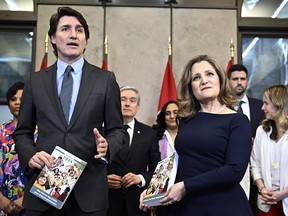Kim Moody: People will search for ways to lower their tax bills when personal tax rates approach 50%

Reviews and recommendations are unbiased and products are independently selected. Postmedia may earn an affiliate commission from purchases made through links on this page.
Article content
I’ve been a long-time critic of Canada’s high personal tax rates. High personal tax rates are a drag on productivity during a time when we desperately need to course correct on that. It also is a large detriment to attracting the best and the brightest and retaining them. High personal income tax rates also discourage entrepreneurship, which Canada desperately needs more of. It is also a very significant factor in successful Canadians leaving the country.
Advertisement 2
Article content
Without government change, however, nothing will happen to correct this. And even then, there’s no guarantee that it will happen.
For example, before 2015, Alberta had, by far, the lowest federal-provincial combined top marginal tax rate in Canada at 39 per cent – the so-called Alberta Advantage. However, that year, the federal Liberal Party came to power and the provincial NDP was surprisingly elected in Alberta. The new federal government promptly announced it was raising the rates on high-income earners by “asking them to pay just a little bit more” (a ridiculous speaking point overused for the next four-plus years) starting in 2016. The Alberta government also introduced new higher rates for 2015 and 2016.
When the dust settled, Alberta’s highest marginal personal tax rate increased to a top end of 48 per cent, a big increase from its previous low and significantly narrowing the gap between some of the provinces that had already increased their personal rates to more than 50 per cent (such as Ontario and Quebec, which had high marginal rates of approximately 53.5 per cent and still do today; British Columbia foolishly later joined that club, along with many of the Maritime provinces).
Article content
Advertisement 3
Article content
While I appreciate Alberta is being fiscally conservative today, it should shed the historical NDP tax increases and reduce its top marginal rate to something more competitive with the United States. A combination of spending cuts and other measures could help make up any shortfall, if any, in taxation revenues.
In discussing Canada’s high personal tax rates with some of my left-leaning friends, someone will occasionally rebut: “Kim, you realize that Canada’s highest marginal rates historically have been in the 80-per-cent-plus range, right? From that comparison, our current highest rates are a bargain.”
Technically, they are not wrong. A 1954 Canadian Tax Foundation publication, Finances of the Nation, shows that the highest marginal rates back then were indeed more than 80 per cent, with the high being 97.8 per cent.
But let’s put some of that into context. First, Canada’s personal income tax system was relatively young from the 1930s to the 1950s. The number of taxpaying individuals, compared to the population as a whole, was very low compared to today.
Advertisement 4
Article content
In addition, capital gains were not taxable back then (capital gains did not become taxable in Canada until 1972). So, of course, there was no shortage of gamesmanship deployed by the small number of high-income taxpayers to convert their income into non-taxable capital gains.
And in 1962, the federal government led by John Diefenbaker had the courage to convene the Royal Commission on Taxation to review the entire taxation system and make recommendations about what Canada should do.
In 1966, the commission released its voluminous report and recommendations. Regarding personal tax rates, the report stated this in Chapter 11:
“We are persuaded that high marginal rates of tax have an adverse effect on the decision to work rather than enjoy leisure, on the decision to save rather than consume, and on the decision to hold assets that provide monetary returns rather than assets that provide benefits in kind. We think there would be great merit in adopting a top marginal rate no greater than 50 percent. With such a maximum marginal rate, taxpayers would be assured that at least half of all gains would be theirs after taxes. We think there is a psychological barrier to greater effort, saving and profitable investment when the state can take more than one half of the potential gain.”
Advertisement 5
Article content
I absolutely agree. In my practice, I witness firsthand the psychological barrier that the commission discussed when the state takes more than half of the gain. It isn’t good.
In 1974, American economist Arthur Laffer discussed a similar relationship between taxation rates and the resulting levels of the government’s tax revenue. The Laffer curve assumes that no tax revenue is raised at the extreme tax rates of zero per cent and 100 per cent, meaning that a tax rate between zero per cent and 100 per cent maximizes government tax revenue.
In my experience, personal behaviours significantly change when personal tax rates approach 50 per cent. People will search for ways to lower their tax bills, especially when the perception is that there is not much value compared to the cost.
The Conservative Party has promised to launch a Tax Reform Task Force within 60 days of taking office to implement lower taxes on work and production, simplify tax rules, cut corporate welfare and reduce the share of taxes paid by the poor and so-called middle class.
With an election coming within the next year (or possibly earlier), there is a real chance that many damaging taxation policies implemented over the past nine years can be changed and new ones introduced. That provides hope to people such as me that better days indeed may be ahead.
Advertisement 6
Article content
Recommended from Editorial
If such a task force is ever convened, we can only hope that lower personal tax rates are on the agenda to ensure people that “at least half of all gains would be theirs” and help improve Canada’s lagging productivity.
Kim Moody, FCPA, FCA, TEP, is the founder of Moodys Tax/Moodys Private Client, a former chair of the Canadian Tax Foundation, former chair of the Society of Estate Practitioners (Canada) and has held many other leadership positions in the Canadian tax community. He can be reached at [email protected] and his LinkedIn profile is https://www.linkedin.com/in/kimgcmoody.
_____________________________________________________________
If you like this story, sign up for the FP Investor Newsletter.
_____________________________________________________________
Bookmark our website and support our journalism: Don’t miss the business news you need to know — add financialpost.com to your bookmarks and sign up for our newsletters here.
Article content








